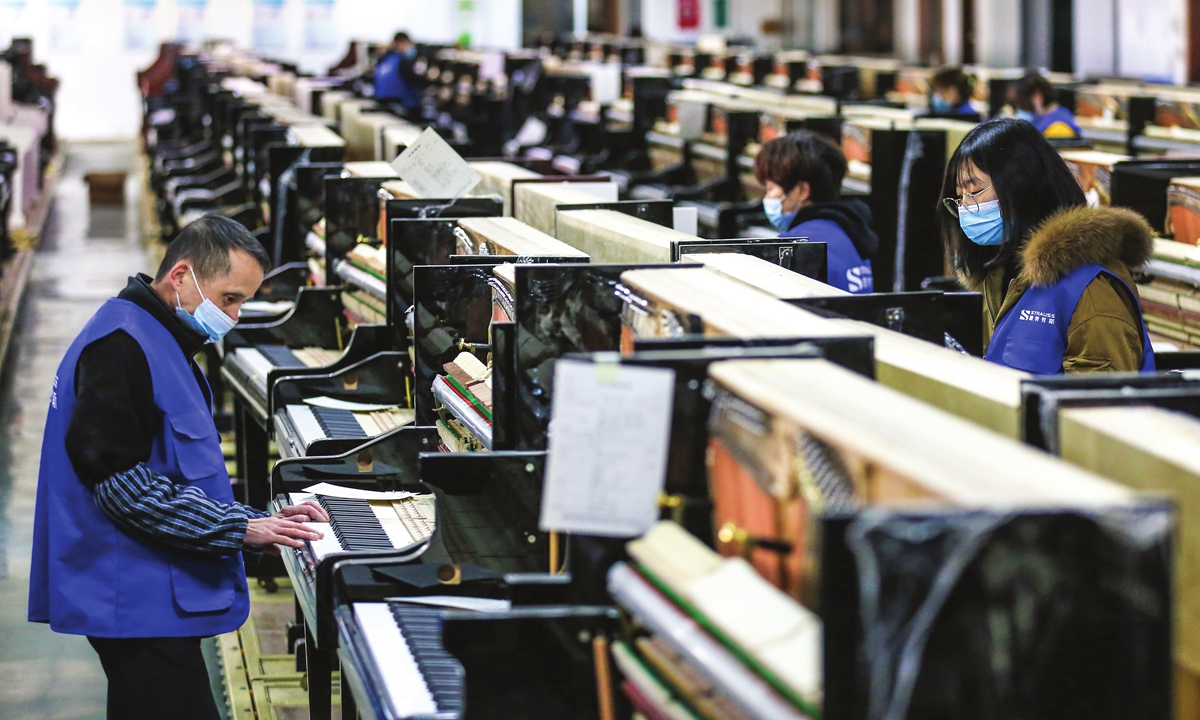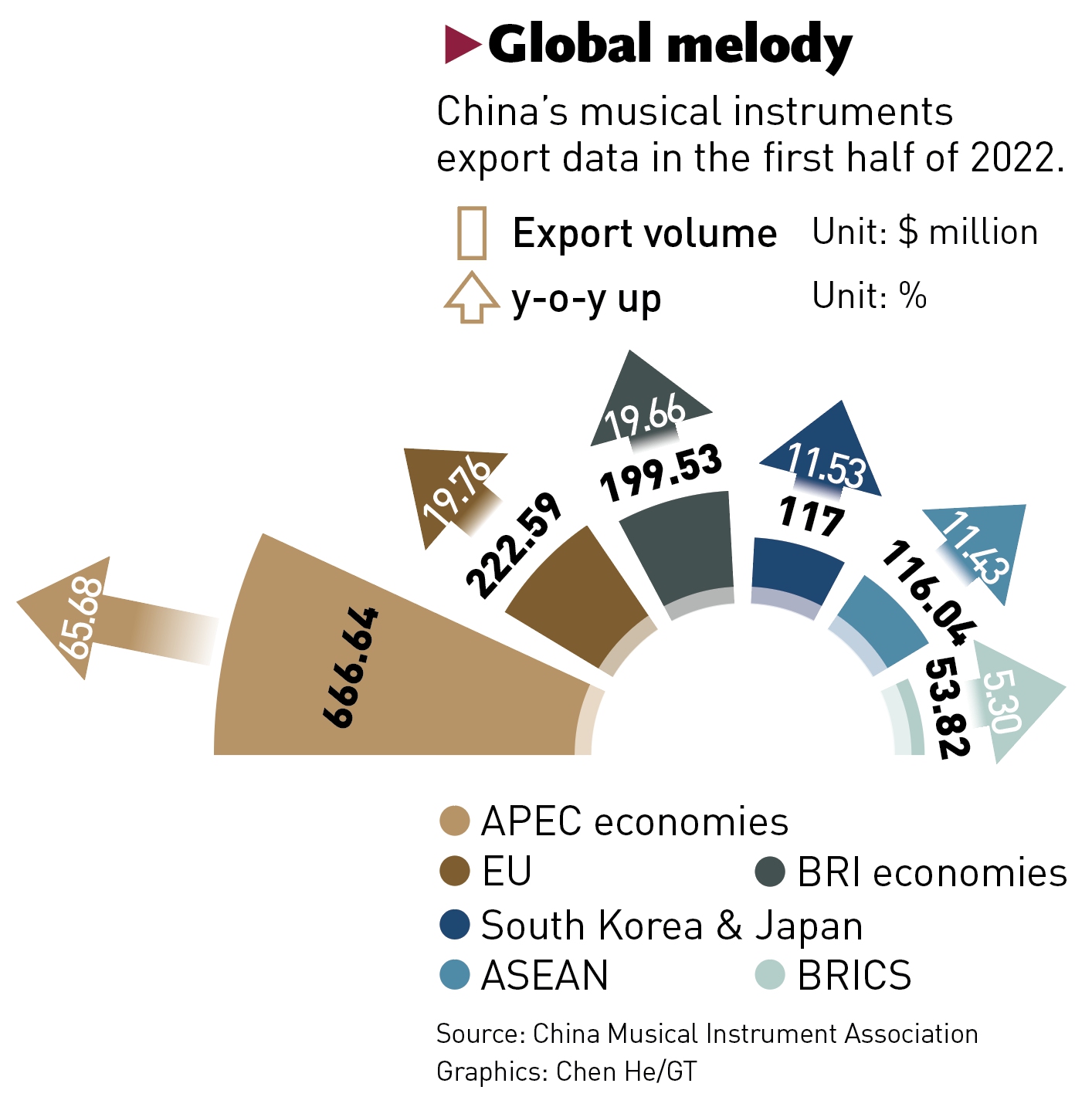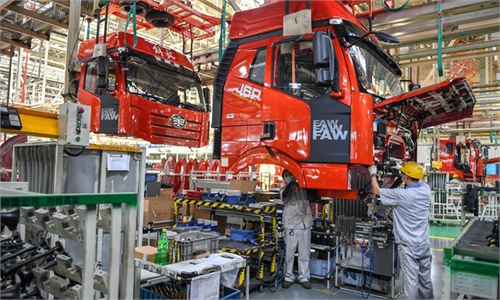Chinese towns underpin the made-in-China brand for global musical instruments
Small towns supply half of the world’s Western musical instruments

A worker checks pianos at a piano factory in Luoshe town. Photo: VCG
Luoshe town, a small town in East China's Zhejiang Province, produces more than 50,000 pianos a year, accounting for one-seventh of China's total piano production. Pianos made here are exported to more than 20 countries and regions including Germany, the US, France, Thailand and Russia.
The booming musical instrument industry represents an epitome of China's musical instrument business across China's villages and townships. From Pianos, violins, guitars, electroacoustic instruments, Western musical instruments made in China, mostly from these little-known townships, accounted to over half of world's total production volume, data showed, as workers in small Chinese towns keep the world musical.
Piano town Luoshe
At present, there are more than 110 piano industry related enterprises in Luoshe town, including 65 piano manufacturing enterprises and 49 accessory enterprises, CCTV reported.
In 2021, the total output value of its piano industry exceeded 600 million yuan ($82.62 million) and 3,000 out of the 24,000 permanent residents work in piano related industries.
Jin Yicheng, who is in charge of Zhejiang Yueyun Piano Co, is among the 3,000 residents in the town involving in piano making.
"This year our piano export volume has picked up 10 percent and the main reason is that we have expanded new customers in the US and South Korea," Jin told the Global Times on Monday, adding that he has seen more orders coming in during the second half of the year.
Compared with foreign competitors, pianos made in China have an advantage in price and manufacturing efficiency, Jin said.
"A high degree of industrialization and standardization in China means that we can meet the needs of customers with a shorter delivery period and meet their customization needs more easily," Jin said.
According to China Musical Instrument Association (CMIA), as the supply chain of China recovered earlier from the epidemic compared with foreign countries, the product supply capacity in China quickly met market demand, promoting the growth of musical instrument exports.
Since 2022, despite repeated epidemic outbreaks and international geopolitical conflicts which led to a contraction of overseas musical instrument markets, overall demand is relatively stable, the association said.
In the first half of the year, China's musical instrument export to Association of Southeast Asian Nations came in at $116 million, up 10.48 percent year-on-year. The export value to APEC economies was up 4.08 percent to $667 million while the export to countries and regions along the Belt and Road Initiative mounted to $200 million, up by 2.32 percent.
Looking forward to the second half of the year, export growth is expected to remain resilient, according to the organization.
Guitar hub
In the first half of 2022, the export of electric musical instruments accounted for 34.77 percent of the total musical instrument export value, which is followed by string instruments, percussion instruments and pianos, according to the association.
Tangwu town in Weifang in East China's Shandong Province is well known for its production and manufacturing of guitars. Eart Music in the town entered the global market in June 2020.
The local industrial park currently has 51 mature factories dedicated to guitar production, which has boosted the development for more than 50 supporting industrial companies in the surrounding area, with a total of 108 companies as of 2022, Zhao Weiguo, the founder of Eart Music, told the Global Times on Monday.
Facing the impact of the COVID-19 epidemic the company moved the majority of operation online and launched shops on Amazon and eBay. Around 10,000 guitars from Eart were sold from June 2020 to June 2021, while the sales topped more than 20 million yuan from the international market, Zhao noted.
"Made-in-China guitars are of a higher quality and a large number of overseas consumers and musicians have expressed their satisfaction on social media platforms such as YouTube and Instagram, which is the best publicity for Chinese brands," Zhao said.
Eart's major consumers are from Europe, the US, and Southeast Asia, with the US having the most consumers at the moment, while the company has recently signed agency contracts with countries including Russia, the UK, Thailand, Singapore, Argentina, Kuwait, and Mexico.

Graphics: Chen He/GT
Moving forward
Advantage in price and manufacturing chain has helped expand production and helped these Chinese towns win a number of orders.
According to data released by the CMIA, the annual output of pianos in China accounted for 69.23 percent of the world's total while the output of major Western musical instruments exceeded half of the global total in 2019.
According to customs statistics, the total export value of China's musical instruments was $2.34 billion in 2021, up 24.26 percent year-on-year.
A challenge for Chinese musical instruments' future development, however, is to establish, perfect and promote domestic brands and their cultures due to being a late comer to the industry, businesses said.
"There is still a gap in branding compared with foreign brands and it is difficult for us to catch up in the short term. On the other hand, some old foreign brands still have advantages in making pianos with top performance, which makes them occupy a large number of high-end markets," Jin said.
Taking electric guitars for instance, electric guitar culture originated from the West, Chinese brands have been developing following the path taken by Western companies, according to Zhao, noting that Chinese companies can meanwhile learn from their experience in production and consumer feedback to improve the design and user experiences for their own products.
At the same time, supportive measures implemented from the government assisting domestic brands in expanding abroad play an indispensable role in the industry development.
Relevant local authorities have been trying everything possible to help regional enterprises, which will be conducive to establish a good business environment for enterprises and operate and develop, said Zhao, adding that the company aims to expand business in 150 countries and regions in the next three years.



